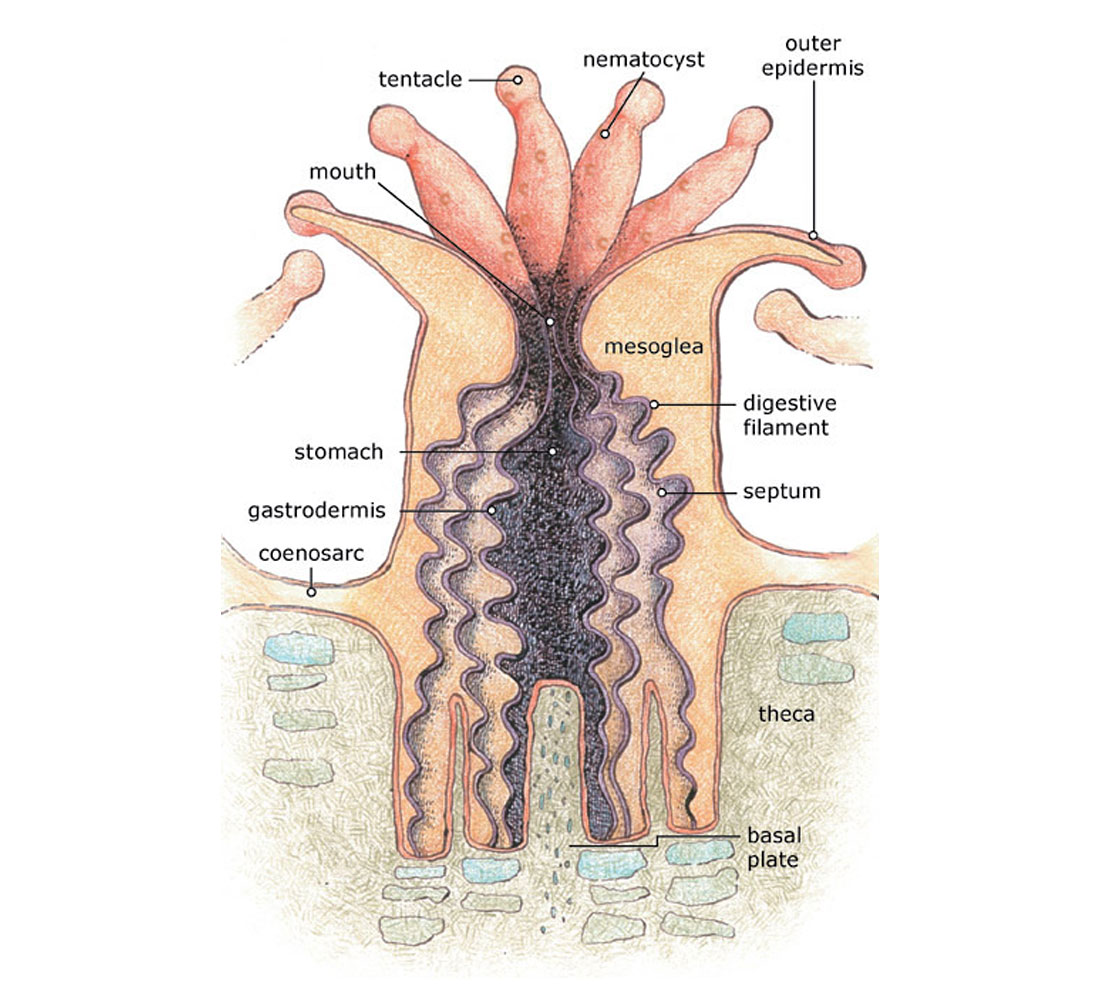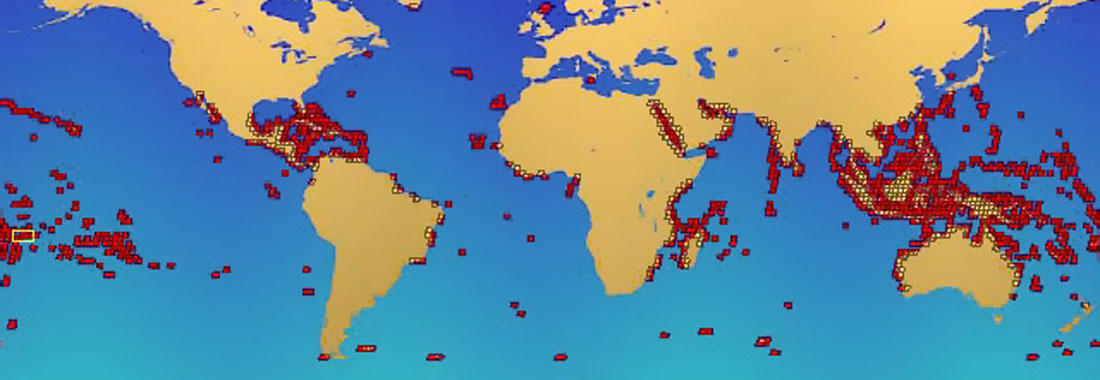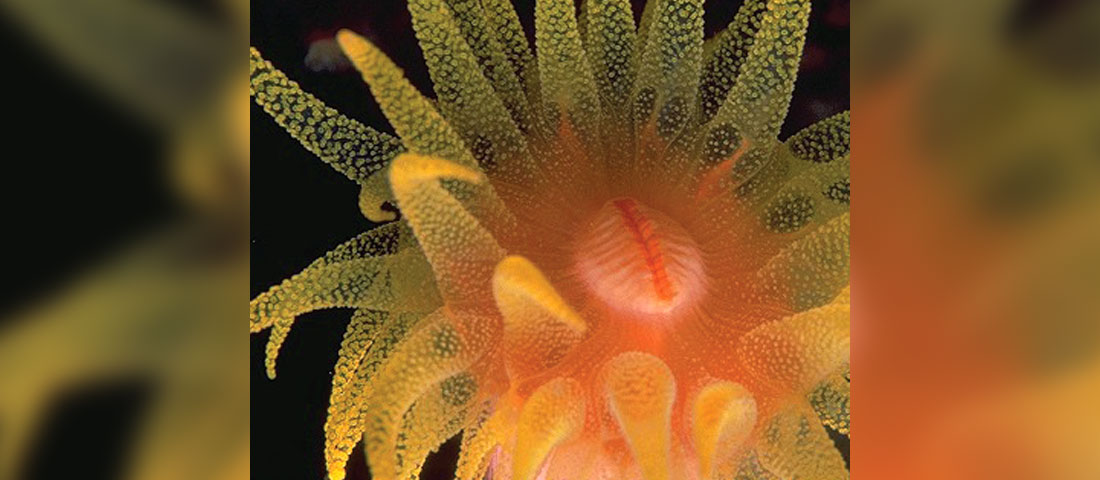Coral colonies create reefs stretching for hundreds of kilometres, and corals are preserved in the Earth’s rocks since the Cambrian; as geoscientists we all know that. But what do we know of the humble coral polyp? The basic facts on this amazing little creature follow. If you read no further, I implore you to watch the award winning video Slow Life (Stoupin, 2014), at time of writing found at: https://vimeo.com/88829079. Science articles often fail to convey the sheer amazement and wonder that originally inspired them, but this short video clip should prevent that.
Taxonomy
That said, let’s start with the mundane world of taxonomy, shall we? Corals are considered invertebrate animals, placed in the kingdom Animalia, and phylum Cnidaria. In Cnidaria are three classes, two of which contain corals. In the Class Hydrozoa are found only two types of corals, lace coral and fire coral, along with a few other polyp organisms including the Portuguese Man of War and Hydra. The class Anthozoa contains all the rest of the numerous varieties of coral, along with many anemones. (The third Cnidarian class is made up of just jellyfish.) Coral taxonomy below the class level is based on number of tentacles (six in the subclass Hexacorallia, eight in Octocorallia), symmetry, and type of exoskeleton. The taxonomy becomes arcane very quickly, with a blurry line between hard corals, soft corals and anemones; this article will focus on what most people consider corals, the over 1,300 species of hard, hermatypic reef-building ones in the order Sceleratinia. There are of course many beautiful and interesting soft bodied ahermatypic corals with proteinaceous skeletons as well.
Reproduction
Most hard corals use a strategy called synchronous spawning. Once a year all the corals in a species release their sperm and eggs on the same night, usually triggered by a full moon or chemical signals. In the resulting reproductive scum, eggs are fertilized and become planulae. Some soft corals are brooders, and they release only sperm, which are spread by wave action, then sink onto waiting eggs. Either way the tiny planulae swim towards the light and in some cases the sound of waves pounding on reefs, then drift around for a few days until settling; most are eaten by predators. If a suitable hard surface is found a planula attaches itself and fully morphs into a larva, starts to secrete and build its calcareous exoskeleton, and eventually develops into adult polyp form. Once established the polyp undergoes asexual reproduction, creating a myriad of genetically identical copies of itself. Such a colony of polyps becomes a coral head, and each species displays a characteristic form or forms. Synchronous spawning can result in hybrid species, an evolutionary advantage. The area known as the Coral Triangle, basically S.E. Asia, seems to act as an incubator for new coral species in this way.
Physiology
Figure 1 shows the basic elements of a hard coral polyp, but keep in mind there are countless variations on this essential structure. Polyps are usually 1-3 mm in diameter, and a couple of centimetres long, species dependent. The tentacles capture prey such as plankton and even tiny fish, and move it to the mouth. Nematocysts near the tentacles contain poisonous dart mechanisms that stun or kill prey. The mouth is used for both ingestion and excretion. The coenosarcs carry metabolites and nutrients between members of the colony, creating an entity that functions like a single organism. The polyps extract calcium from the sea water, and build aragonite bases made of cup-like calyxes in which they sit, on top of annular rings with six spoke-like ridges that provide structural rigidity. These aragonite (CaCO3) bases form coral reefs – once a polyp dies, its calcareous base remains, providing an anchor for a new polyp. Over time the massive reefs seen in today’s oceans and in the geologic record form. Note that today’s Sceleratinia corals are not the same as the Tabulate and Rugose corals seen in Paleozoic rocks.

Hard corals require a dietary supplement provided to them via symbiosis. On their tentacles and in their stomachs lives a type of photosynthetic brown algae named Zooxanthella, making up ~30% of the material in a polyp. In exchange for a home, protection, and certain compounds required for photosynthesis, the algae gives back all its photosynthetic byproducts – oxygen, amino acids, glucose, and glycerol – providing the polyps with almost 95% of their nutritional requirements. With this assistance the polyps can create the aragonite, as well as fats, proteins and carbohydrates, and this allows them to be such productive builders, and to thrive in nutrient- poor water. In fact, the less nutrients in the water the better, because clear water makes for better photosynthesis. However this dependence on Zooxanthellae means the hard corals can only live in waters with bright sunlight, effectively limiting their habitat to the top 60 m of water, and +/-a 30° band around the equator (Fig. 2).

Soft bodied corals do not need algae to survive, so are found down to 4,000 m depth, and at higher latitudes. However, without the extra boost from Zooxanthellae they are not as productive or plentiful. One such black coral called Leiopathes glaberrima can live for over 4,000 years! Unfortunately these soft corals, with their slower metabolisms and unusual colours, have been aggressively collected by humans for making jewelry and other forms of ornamentation, to the point of extinction.
Threats
While a boon to the hard corals, Zooxanthellae also represent a grave threat. Too much oxygen is toxic to coral, so hosting the algae puts a certain strain on the polyps. If stressed, polyps eject algae to survive in the short term. Normally the corals retain some Zooxanthellae or are able to reacquire them, eventually returning to health, but increasingly the algal loss is permanent and leads to the death of the entire colony; this is known as coral bleaching. This serious threat to the health of the world’s reefs, including all the thousands of other species supported in the reef ecosystems, is typically caused by elevated water temperatures. All Zooxanthellae are temperature sensitive, some more than others. Once the temperature gets above ~30°C, thylakoid membrane walls within the algae are damaged, and during photosynthesis allow more than normal numbers of toxic O2-radicals to pass through to the host polyps, which react by massively ejecting the algae, ultimately leading to bleaching and death.

There are numerous other threats to corals, both natural and anthropogenic: storm damage, acidification, silting, pollution (pesticides, herbicides, sewage, etc.), natural predators, trawling, coral mining and collecting, cyanide fishing, muro-ami netting, dynamite fishing, dredging, and on and on. While people like us are deafened by bombastic media coverage on global warming and tune it all out, the gradual but accelerating loss of the world’s coral reefs is occurring under our noses – a tragedy.











Share This Column